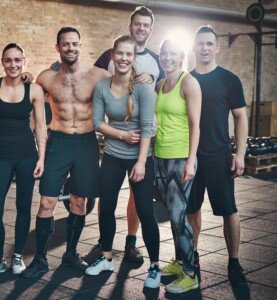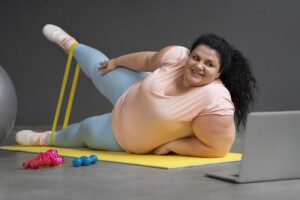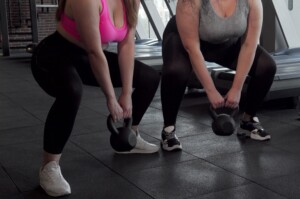Here are 12 ways you can make your ASD blend in well with sensory over-stimulation of the gym environment.
For some autistic individuals, gym sensory overload and social dynamics can make it a bit tricky to get in a good workout.
But at the same time, you as the health conscious Autistic realizes the value of consistent structured workouts.
If you’d like to work out at a gym but anticipate too much sensory overload, or if you’re already visiting the gym but dread the over-stimulation, here are 12 ways to get around that.
Choose Off-Peak Hours

Let’s kick things off with a game-changer: Hit the gym during its quieter hours if your schedule allows.
Early mornings or late evenings usually mean fewer people, less noise and more breathing room.
Less crowded times will vary from gym to gym, so ask the manager what time windows have the fewest visitors.
Create a Visual Schedule

Freepik.com/rawpixel.com
Visual aids can be your best workout buddy. Consider making a visual schedule that breaks down your gym routine step by step.
This helps you know what to expect and reduces anxiety about the unknown.
Be creative with your visual schedule; use different color markers, shimmering sticker stars, etc.
Or there are also apps available for scheduling.
Noise Canceling Headphones

Block out the noise with a pair of noise canceling headphones.
Listen to some metal, classical or whatever charges you up, or listen to a calming podcast, creating a bubble of auditory comfort in the bustling gym environment.
You can also use the type of headphones that hunters or airport workers use: no music; just a big reduction in the volume of ambient noise.
You may also want to pair these up with earplugs if the gym’s overhead sound system is still too loud or bothersome despite having headphones on.
Custom-made earplugs will work best; you can get fitted for these at a hearing clinic.
They may run around $200, but over time will pay for themselves, as they will last for many years. I speak from experience!
Additionally, depending on your workout at a given time in the gym, you can find an area to do it that’s not near the overhead speakers.
Find a Quiet Corner

Shutterstock/pikselstock
Scout out the gym for a quiet corner or less crowded area.
Whether it’s a tucked-away yoga space or a corner with lighter foot traffic, having your own space can make a world of difference.
Communicate with Staff

Flamingo Images
Don’t hesitate to communicate your needs with gym staff.
Share your concerns and ask about quieter times or available accommodations, such as a designated quiet space.
Your best bet is to speak to the gym’s manager.
Use Social Scripts

Social situations can be tricky, but having a few social scripts prepared can make interactions smoother.
Practice simple responses for common gym interactions, making socializing a breeze.
But remember, you’re not there to socialize. Every gym has a few people who talk more than they actually exercise, and they seem to be there simply for social interaction.
That’s THEM. You don’t have to socialize with anyone. This includes the most social person in the gym.
Wearing headphones, even if the noise doesn’t bother you, will go a long way at steering strangers away from starting chitchat with you.
Start with Small Steps

Freepik.com
If the gym feels overwhelming initially, start with short visits and gradually increase the duration.
This gradual exposure helps your body and mind acclimate to the environment, reducing the potential for overwhelm.
Also start off with simple exercises. Workouts do not need to be fancy or complicated.
Bring a Supportive Buddy

Shutterstock/Nata Kotliar
Having a supportive friend can make the gym feel like a more welcoming space.
Choose someone who understands your needs and can provide encouragement, making the experience more enjoyable.
Incorporate Sensory Tools

Sensory tools like fidget toys or stress balls can offer a discreet way to manage sensory input.
Having a small item in your pocket can be a great comfort during your workout.
Feel free to use body parts to stim between workouts. I’ve been working out at gyms for many years, and I honestly can affirm that neurotypicals themselves probably stim far more at gyms than in any other environment.
I often see NTs (presumably NTs, being that I see this among so many gym-goers) stimming in between sets.
The most common stim is the leg shake (aka knee bounce) while they’re seated.
Another relatively common repetitive movement by NTs at the gym is that of rocking from side to side while standing.
If you have an urge to flap your hands, spin, hop a little or conduct other body stims in between sets, the gym environment will water down how these repetitive movements appear to NTs.
NT stims are seen as either mental prep for the next set, a recharging from the previous set or just a habit developed by a fitness enthusiast. It’s a GYM! Anything goes!
Mindful Breathing Techniques

Practice mindful breathing techniques to center yourself in moments of stress.
Slow, deep breaths can be a powerful tool to stay grounded and manage anxiety during your workout.
In addition, when strength training, never hold your breath. Instead, inhale as you lower or release the weight, and exhale as you exert the force (e.g., pressing the resistance away from you or pulling the resistance towards you).
Set Clear Goals

Having clear and achievable fitness goals can provide structure to your workout.
It gives you a sense of purpose and direction, making the gym experience more focused and less overwhelming.
Celebrate Small Victories

Shutterstock/Michaeljung
Lastly, celebrate your victories – big and small.
Every gym session is a step toward your goals, and acknowledging your achievements boosts confidence and motivation.
Summary for Strategies to Combat Gym Sensory Overload

©Lorra Garrick
Remember, everyone’s fitness journey is unique, and finding what works best for you is the key.
As an Autist myself, I will say it bluntly: Autism is NO excuse for having a weak, flabby, out-of-shape body – even if you have issues with coordination.
Many strength training and other exercises do not require coordination, or, require only very minimal coordination.
 Lorra Garrick has been covering medical and fitness topics for many years, having written thousands of articles for print magazines and websites, including as a ghostwriter. She’s also a former ACE-certified personal trainer. In 2022 she received a diagnosis of Level 1 Autism Spectrum Disorder.
Lorra Garrick has been covering medical and fitness topics for many years, having written thousands of articles for print magazines and websites, including as a ghostwriter. She’s also a former ACE-certified personal trainer. In 2022 she received a diagnosis of Level 1 Autism Spectrum Disorder.
.



























